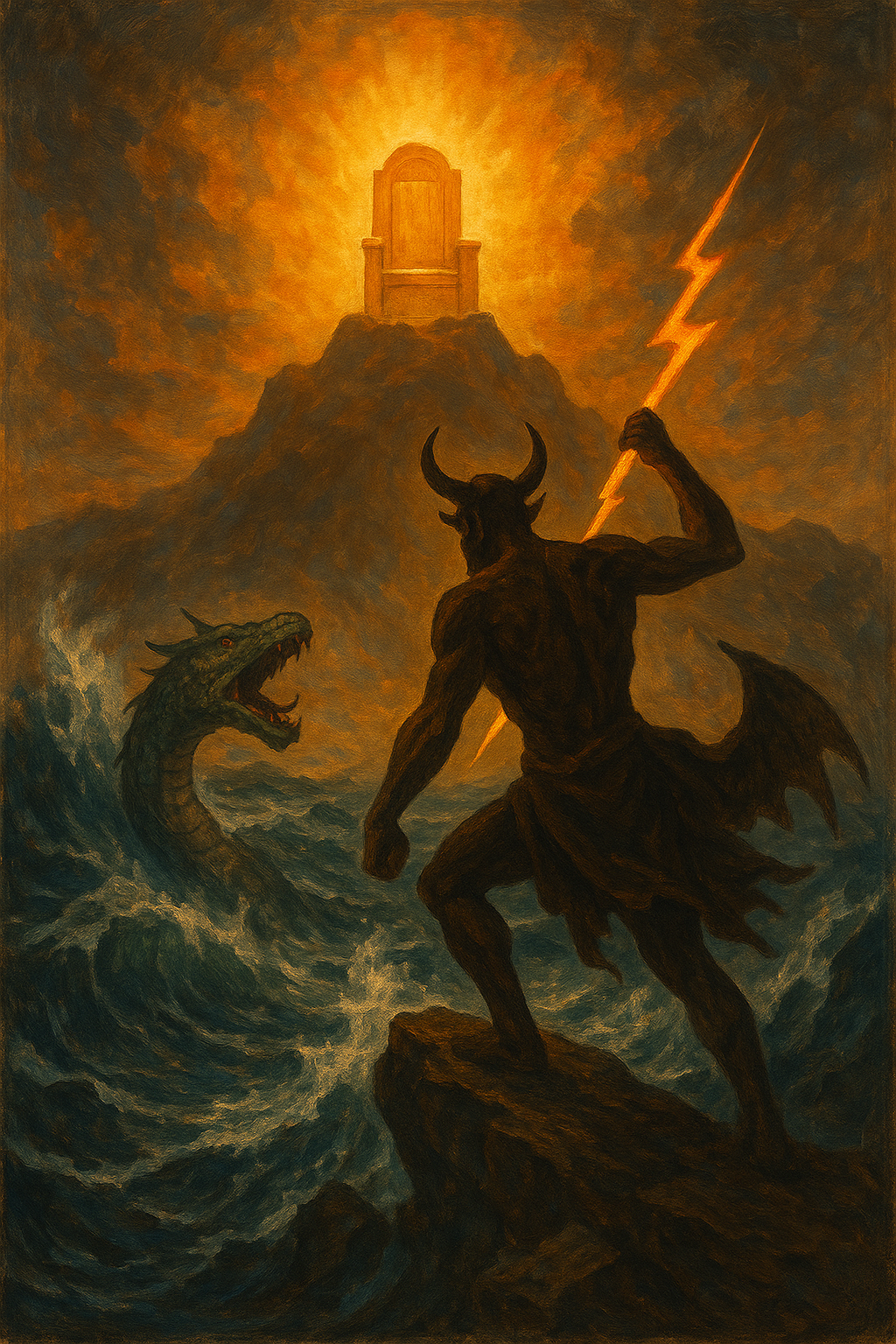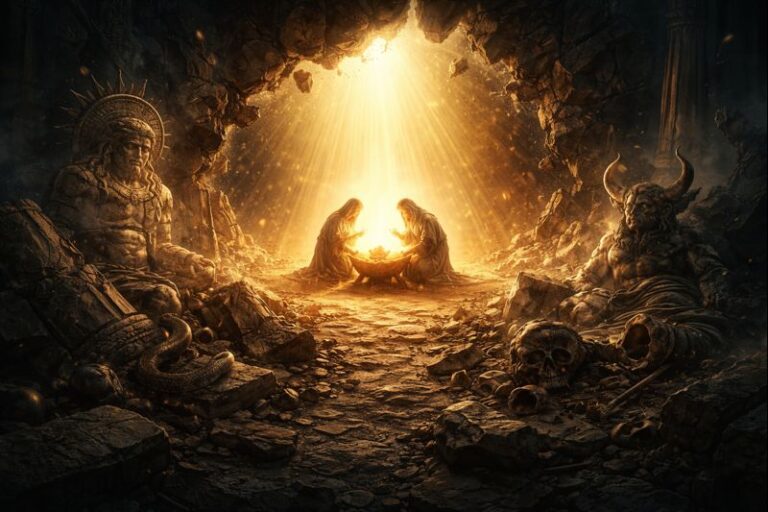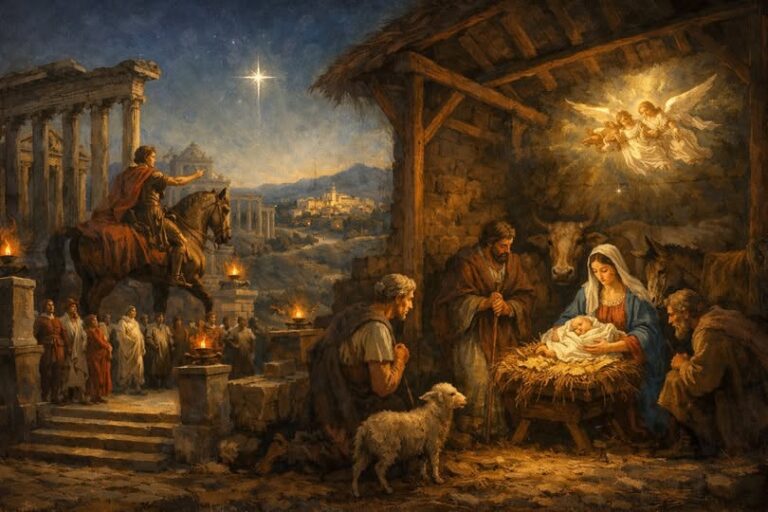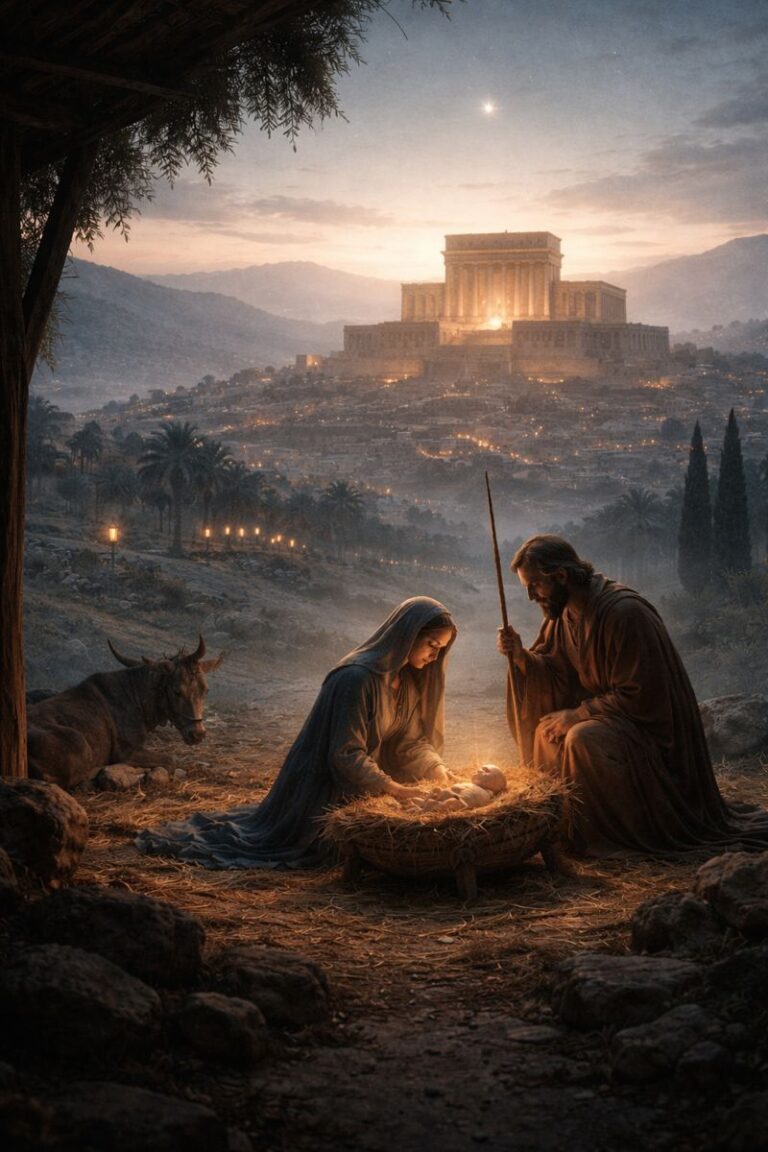
The Bible was written in a world where stories about gods and cosmic battles filled the air. Nations told tales about their deities, gods of storms, fertility, death, and sea, who struggled for power and demanded loyalty. These myths weren’t just fantasy; they were theological claims. One of the most prominent of these stories was the Baal Cycle, a collection of Ugaritic poems found in ancient texts near modern-day Syria. Baal was the storm-god of the Canaanites, the chief rival to Yahweh in Israel’s theological landscape.
To the ancient reader, Baal was not a cartoon idol. He was a serious figure with deep cultural roots, and his story offered a rival explanation for the world’s order and who sat on the divine throne. But the Bible doesn’t ignore Baal. It addresses him directly, referencing his stories, echoing their structure, and then tearing them apart from the inside. These echoes do not mean the biblical authors accepted Baal’s mythology. Rather, they used it as a weapon to expose a deeper enemy hiding behind the name.
The Baal Cycle was not just myth. It was propaganda. It was Satan’s story told under another name. Baal is Satan, and the Bible treats him that way. The lesson of Scripture is not simply that Baal is false, but that Baal is the face Satan wore in the ancient world to deceive the nations. The biblical writers confront this lie on its own terms and destroy it from within.
The Baal Cycle: The Rebel’s Story
The Baal Cycle is a series of ancient Ugaritic texts dated to the 14th century BC, written in a language closely related to Hebrew. It tells the story of Baal, the god of storms and fertility, who rises to power by defeating rivals and building a throne. Baal’s primary enemies are Yam, the god of the chaotic sea, and Mot, the god of death and the underworld. In the process of asserting his rule, Baal builds a palace on Mount Zaphon, establishing his authority among the gods. Even El, the high god of the pantheon who initially resists Baal’s rise, eventually gives him permission to build his temple and supports his kingship.
That last detail is key. El does not grant Baal authority from a place of strength or legitimacy. He yields out of fear. The myth portrays Baal as gathering support from powerful allies and rising so quickly that even the supposed creator-god feels threatened. El is not wise or holy. He is weak and easily manipulated. This is the theological inversion at the heart of the Baal Cycle. It replaces divine sovereignty with political survival. Authority is not given. It is taken. And when El finally approves the construction of Baal’s palace, it is not because Baal is worthy, but because El is afraid to resist him any longer.
The description of Baal’s palace adds even more weight to this counterfeit. It is constructed on Mount Zaphon, the symbolic cosmic mountain, and described as being built from precious materials such as cedar, silver, and gold. This parallels the divine dwelling of Yahweh in biblical texts. The language mirrors passages like Ezekiel 28, which describes the holy mountain of God adorned with radiant stones, and Revelation 21, where the heavenly city is constructed from gold and gems. The palace also serves as Baal’s seat of judgment and thunder, echoing how Yahweh’s throne is associated with lightning, clouds, and the voice that shakes the heavens in passages like Psalm 29.
More than that, the myth portrays Baal as seeking to unite all the other gods under his rule. He does not merely wish to coexist with the divine assembly. He wants to dominate it. His goal is to be recognized as the supreme authority among the elohim, to become king of the gods. This mirrors exactly what Satan desires in passages like Isaiah 14, where he says, “I will ascend above the stars of God. I will set my throne on high.” Satan is not content to oppose God. He wants to replace Him and draw the allegiance of the entire heavenly host.
This is no coincidence. Baal is not content with power. He wants to be seen as the supreme divine king. He does not simply defeat rivals. He imitates the heavenly throne room itself and demands loyalty from the council. The palace is a statement. It says Baal has arrived, not just as a god among gods, but as the one who has taken his place on the sacred mountain, built his own Eden, seized the loyalty of the host, and claimed what only the true God deserves. That makes the Baal Cycle more than a pagan myth. It makes it a direct challenge to Heaven.
This reversal of divine order, where the creature forces his creator into submission, builds his own throne, and seeks to unify the divine beings under his own name, reflects exactly what Satan desires. He wants to be seen as the rightful ruler who ascended when the creator faltered. This is not just rebellion. It is a counterfeit gospel. It is Satan’s justification for his war against God, told through the myth of Baal.
How the Baal Cycle Shows Up in the Bible
The biblical authors knew the Baal Cycle. The language, structure, and theological claims of the myth appear throughout Scripture, not because the Bible agrees with them, but because the Bible is at war with them. Every echo is a reversal. Every reference is a rebuke. The goal is not to repeat the myth but to confront and destroy the satanic narrative hiding beneath it.
In the Baal Cycle, Baal defeats Yam, the god of the sea, and earns the right to reign. In the ancient world, the sea represented chaos and opposition to divine order. Baal’s triumph over Yam was his defining victory. But in Scripture, that power is not Baal’s. It is Yahweh’s. Psalm 74 says that Yahweh split the sea and crushed Leviathan. Job 26 says He shattered Rahab and calmed the deep. Isaiah 51 describes Yahweh piercing the sea monster and making a way through the waters. These are not casual references. They are declarations that the sea was never Baal’s to tame. Yahweh, not Baal, commands the chaos.
The mountain is another key image. In the Baal Cycle, Baal builds his palace on Mount Zaphon, a cosmic mountain that symbolized divine rule. But in Psalm 48, Mount Zion is described using the same language. It is called “in the far north,” a phrase that deliberately mimics the description of Zaphon. The point is clear. The mountain belongs to Yahweh. The throne sits in Jerusalem, not in Canaanite myth. The biblical authors take Baal’s claim and apply it to the true King.
Baal’s confrontation with death also appears in Scripture, only reversed. In the myth, Baal is swallowed by Mot and eventually escapes. His victory is fragile and incomplete. But Isaiah 25 announces that Yahweh will swallow death forever. Hosea 13 taunts the grave, asking where its power has gone. In the New Testament, this is fulfilled in Christ, who rises not by trickery, but by divine authority. Death is not endured and escaped. It is crushed and emptied.
Jesus Himself makes the connection between Baal and Satan explicit. In Matthew 12, when the Pharisees accuse Him of casting out demons by the power of Beelzebul, He answers by exposing their hypocrisy. Beelzebul, meaning “exalted Baal,” was a title drawn directly from Baal worship. Jesus accepts their term and applies it to Satan without correction or distinction. The implication is unmistakable. The power the world once attributed to Baal is the same power He now calls Satan’s. The ancient Canaanite god and the adversary of God’s people are one and the same. When Jesus speaks of Satan’s kingdom being divided, He is declaring the end of the rule Baal once claimed for himself.
The biblical authors do not tiptoe around these parallels. They weaponize them. Baal is not just a false god. He is Satan wearing the mask of divinity. His story is Satan’s lie, told again and again in every nation that rejected Yahweh. The Bible uses that story against him. It exposes his ambition, mocks his counterfeit mountain, and shatters his claims to power. This is more than theology. It is spiritual war.
Did the Bible Copy Canaanite Myth?
Some critics argue that the Bible borrows its theology from older myths like the Baal Cycle. They point to the shared imagery of cosmic mountains, divine councils, and storm gods to claim that Yahweh is just a regional reworking of Baal. But this accusation misunderstands what the biblical authors were doing.
The Bible does not copy Canaanite myth. It confronts it. The similarities are not evidence of theft, but of polemic. The biblical writers were fully aware of the Baal Cycle and other ancient myths that circulated in their cultural world. They referenced those stories in order to expose them. Instead of endorsing Baal’s tale, the Bible flips it on its head. The God of Israel is not one rebel god among many. He is the Most High from the beginning, never threatened, never overthrown, and never afraid. He does not ascend through conquest or deception. He reigns because He alone is Creator.
This is why Yahweh rides on the clouds (Psalm 104:3), defeats the sea (Psalm 89:9–10), and speaks with thunder (Psalm 29). These are not signs that He was made in Baal’s image. They are signs that Baal was a pretender, using the divine symbols that rightfully belong to Yahweh. The biblical authors knew the stories. They didn’t adopt them. They dismantled them and pointed the audience back to the true King.
Conclusion
Baal is Satan. The Baal Cycle is not just myth or error. It is a blasphemous declaration of rebellion, authored by the enemy himself and received as truth by the nations. In that story, the Creator is distant and corrupt. The rebel is brave and victorious. The throne is up for grabs, and power belongs to the bold. This is what Satan wants the world to believe.
But the Bible answers this story with fire. Yahweh is not weak. He is holy. He is not distant. He is present. He is not overcome. He reigns forever. The sea does not belong to Baal. The mountain is not Zaphon. The grave is not victorious. The throne was never empty. The one who rules is not a created rebel, but the uncreated King.
The Bible does not just deny Baal’s story. It reverses it, undoes it, and exposes it. The myth Satan told through Baal is dismantled line by line in Scripture. Every poetic claim is met with a prophetic rebuke. Every false symbol is re-aimed against its maker.
In the end, the mountain still stands. The throne still stands. But they do not belong to Baal. They never did. The counterfeit has failed. The rebel has been unmasked. Yahweh reigns, and no created being will ever take His place.
Discussion Questions
- How does the biblical portrayal of Yahweh challenge and dismantle the claims made in the Baal Cycle?
- Why is it significant that Jesus directly connects Baal to Satan in Matthew’s Gospel, and what does this reveal about the spiritual nature of ancient myths?
- What can the language and imagery of Baal’s palace tell us about Satan’s desires and the biblical depiction of divine authority?
- In what ways does the Bible use familiar mythological structures not to affirm them but to correct and subvert them? Can you think of other biblical examples of this pattern?
- How does understanding the Baal Cycle help us better grasp the meaning of passages like Isaiah 14, Ezekiel 28, or Revelation’s imagery of the dragon and the sea?
Want to Know More?
- Stephen De Young – The Baal Book: A Biography of the Devil
This recent work traces the biblical portrayal of Baal as a manifestation of Satan himself. De Young examines the Baal Cycle, its influence on Israel’s religious environment, and how Scripture systematically unmasks Baal as a cosmic rebel whose story mirrors Satan’s counterfeit gospel. - Michael S. Heiser – The Unseen Realm: Recovering the Supernatural Worldview of the Bible
Heiser outlines the divine council worldview and shows how biblical writers often engage in polemic against rival gods like Baal. His work provides critical theological background for understanding why Baal is treated as more than a mere idol. - Mark S. Smith – The Ugaritic Baal Cycle: Volume I – Introduction with Text, Translation and Commentary of KTU 1.1–1.2
Smith delivers the foundational academic resource on the Baal Cycle, including full translations of the primary Ugaritic texts. It’s essential for understanding the mythic framework the Bible is directly confronting. - John Day – Yahweh and the Gods and Goddesses of Canaan
Day investigates how Baal, Asherah, and other Canaanite deities appear in both archaeological findings and biblical texts, showing how the Old Testament systematically opposes their worship. - Paul R. House – Old Testament Theology
House provides a theological overview of the Old Testament and highlights how Yahweh’s character, kingship, and holiness are portrayed in deliberate contrast to pagan gods like Baal throughout Israel’s history.




